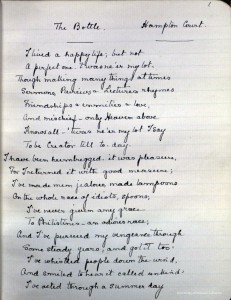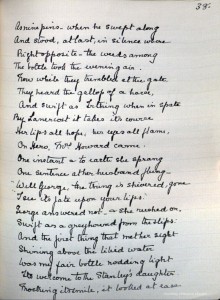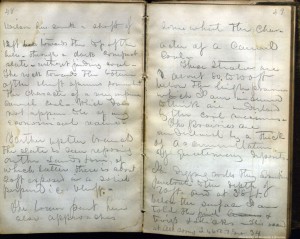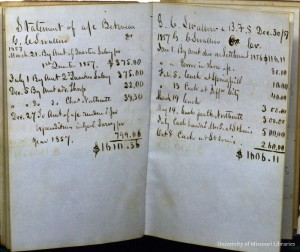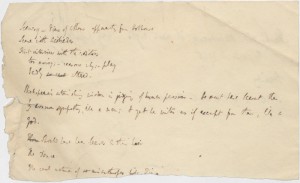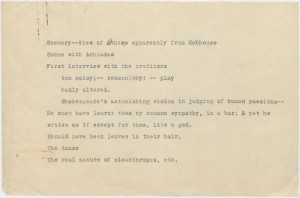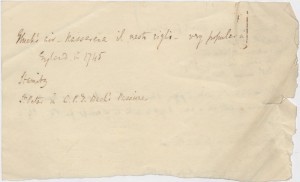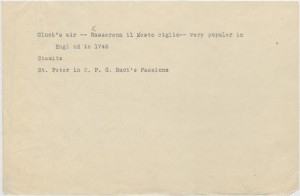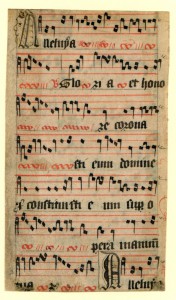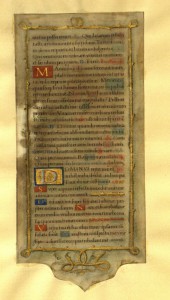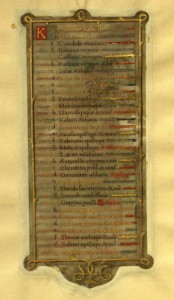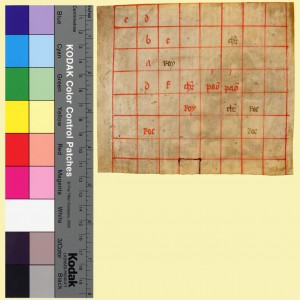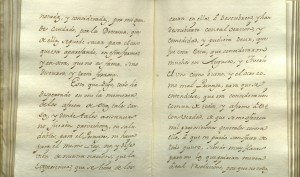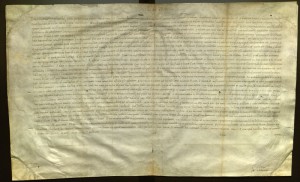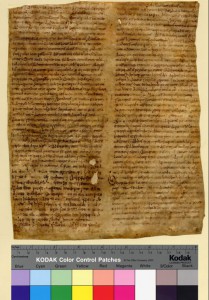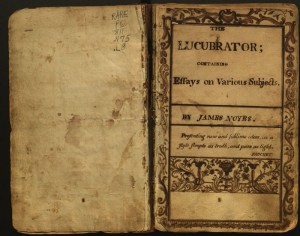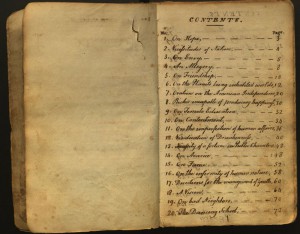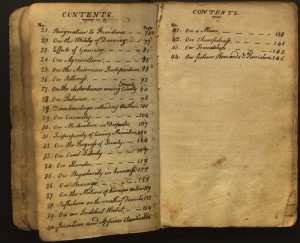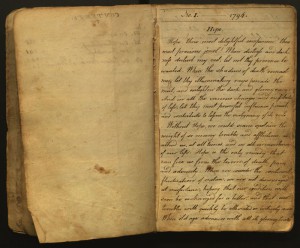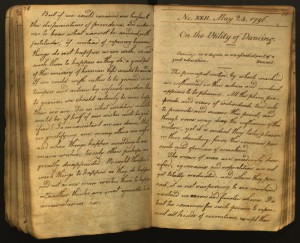In honor of St. Patrick's Day, this week's manuscript is by Stopford Brooke, an Irish writer whose humorous poem, "The Bottle," is now part of the Mary Lago Collection. While on a picnic with George and Rosalind Howard, Earl and Countess of Carlisle, Brooke threw a wine bottle into a pond at Hampton Court Palace. The Howards became obsessed with sinking the bottle, but failed to do so.
manuscripts
Bejamin Franklin Shumard’s field notebooks
This week's manuscripts are the field notebooks of Benjamin Franklin Shumard. Shumard and G.C. Swallow (the namesake for Swallow Hall) completed a geological survey of Missouri in 1855-1858. The notebooks were donated to the MU Libraries by a relative, Miss Shumard, in 1910.
Shumard was a medical doctor who focused on geology for the first part of his career; working in various states on geological surveys beginning in 1846. In 1858, he left Missouri for Texas, but he returned in 1860 and lived in St. Louis until his death in 1869. He was a professor of obstetrics at the University of Missouri medical school (located in St. Louis at the time) and president of the St. Louis Academy of Science. (From the Handbook of Texas Online)
We're not sure to what extent these notebooks have been published. Shumard left the Missouri Geological Survey before the work was completed, but his observations are noted in later publications. There are papers relating to Shumard's work at the Missouri State Archives, the Missouri State Historical Society, and the Texas State Archives.
Leigh Hunt letters
Leigh Hunt was a poet, journalist, and essayist who was influential among the Romantic poets, including Byron, Keats, and Shelley. Special Collections has a small collection of Leigh Hunt's correspondence dating 1823-1959, with the bulk of the material falling between 1831 and 1861. The collection contains letters to and from various correspondents, including Leigh Hunt's oldest son, Thornton. A large portion of the correspondence consists of transcribed letters, for which the originals are lacking.
These materials are in the process of being digitized. We're sharing a few scans below; look for the rest in the MU Digital Library soon.
A fragment of a fifteenth-century gradual
The Fragmenta Manuscripta collection is again the source of this week's feature. It's a fragment from a fifteenth-century gradual in Latin, possibly from England. Note the square musical notation on a four-line staff. The staff here agree that we particularly like the face in profile added to the large initial. More information at the Digital Scriptorium.
Fragments from a Book of Hours
No librarian is happy to see a broken book, but we're lucky to have eight leaves from this sixteenth-century book of hours. Two of the leaves in Special Collections were originally part of John Bagford's Fragmenta Manuscripta collection – meaning they were removed from the book by the late seventeenth century. Bagford's fragment collection passed to St. Martin-in-the-Fields in the eighteenth century. The collection was sold in 1861 to Sir Thomas Phillipps, then to Sir Sydney Cockerell in 1913. In 1957, the collection was bought by the bookseller William Salloch, and it came to the University of Missouri in 1968.
The remaining parts of the manuscript (it's not clear how much) were eventually broken around 1920. In the 1980s, Margaret Howell, then director of Special Collections, noticed a set of six leaves on the market, and she was able to reunite at least a portion of this beautiful book of hours.
All eight of the leaves are cropped in the same manner and show signs of damage from flooding in London in 1846. The manuscript was produced in the style of Geoffroy Tory, an influential type designer of the Renaissance. This humanistic script may look printed, but it's all written by hand. See more in the Digital Scriptorium: Fragmenta Manuscripta #212, #213, and the six additional pages.
For a great recent overview of the topic of book breaking and its implications for libraries, see This Just In: Breaking Bad by David Whitesell at the Albert and Shirley Small Special Collections Library, University of Virginia.
Medieval Chess Problem
How about a little brainteaser with your Monday manuscript? This is a chess problem from a fourteenth-century manuscript. It's Fragmenta Manuscripta #194. The entire Fragmenta Manuscripta collection is online at the Digital Scriptorium.
Carta de el secretario
For this week's manuscript, we're posting a couple of pages from Carta de el secretaro, Antonio Perez, al duque de Lerma de la manera que seharia de governar en la privanza.
The manuscript was produced between 1568 and 1579. It's quite a long letter written by Antonio Perez, secretary to Philip II of Spain, addressed to the duke of Lerma, providing advice for princes on governing from privilege, illustrated with examples from the Spanish court. Find it in the MERLIN catalog.
A letter of Pope Leo X
Happy Manuscript Monday! This week's offering is a letter from the papal chancery of Pope Leo X, written in Rome on March 27, 1517, to Ottaviano Fregoso, Doge of Genoa. The letter is signed Jacopo Sadoleto as papal secretary and was written by the papal scribe, Ludovico degli Arrighi. In addition to being a papal scribe, Arrighi was a type designer and author. His typefaces, based on his own elegant script, have influenced the design of fonts and letter forms from the Renaissance to the present.
A ninth-century fragment of De orthographia by Bede
This semester, we're kicking off a new series. Every Monday, we'll share a page or two from the department's manuscript holdings – just enough to give you a glimpse into the collections.
First up: the oldest manuscript in the collections, a fragment of De orthographia by Bede from the 9th century (Fragmenta Manuscripta #002). Fragmenta Manuscripta is a collection of leaves, clippings, and binder's waste assembled by bookseller John Bagford in the late seventeenth or early eighteenth century. It's fully digitized – find out more about it at Digital Scriptorium.
Stay tuned next Monday for another manuscript from the collections.
Unsolved Mystery #6: The Lucubrator by James Noyes
Our final unsolved mystery of the semester is a manuscript donated to the MU Libraries by Mrs. Edwin Ball in 1974. Its title page attributes the work to James Noyes, but we know very little else about it. It consists of a series of essays on a wide variety of topics. Titles include "On Female Education," "On Bad Neighbors," and "On the Utility of Dancing," to name a few. The essays are dated between 1794 and 1797. James Noyes (1778-1799) wrote a mathematics textbook and a couple of almanacks around 1793-1794, but we have not been able to establish whether he and the author of this manuscript are one and the same.
Who was James Noyes? Is this manuscript in his hand? Where was it created? Were the essays ever published?
As always, email us at SpecialCollections@missouri.edu with your thoughts on this unsolved mystery.
